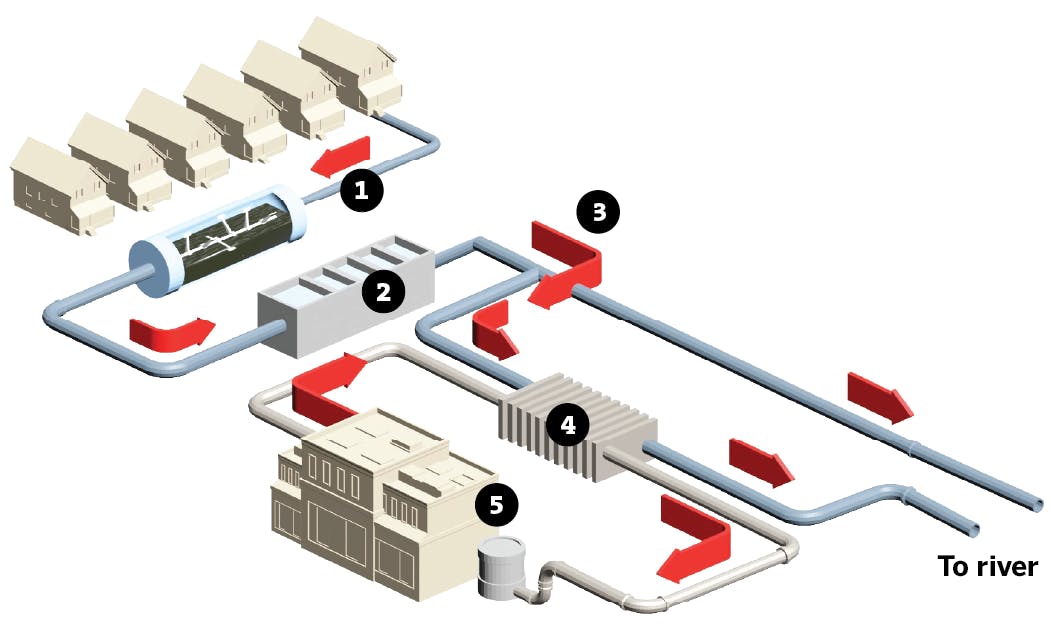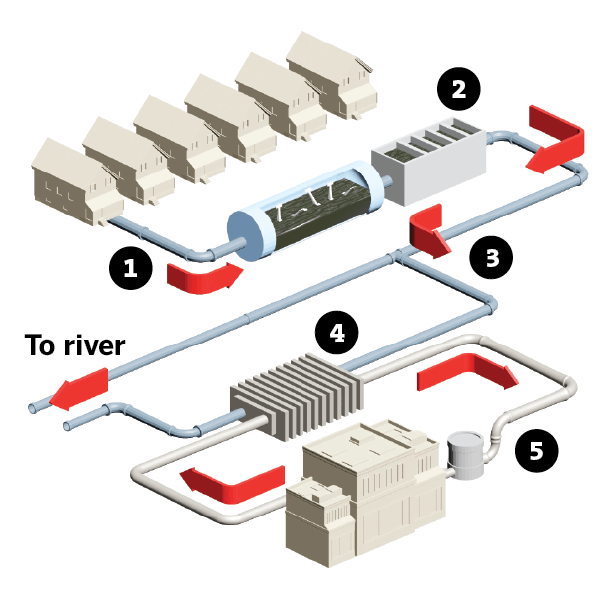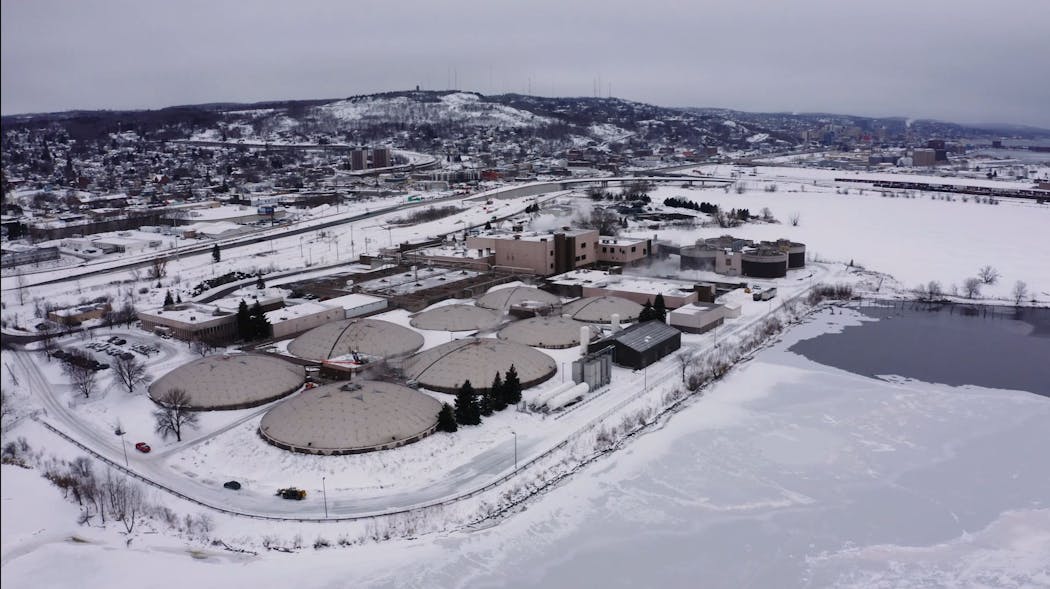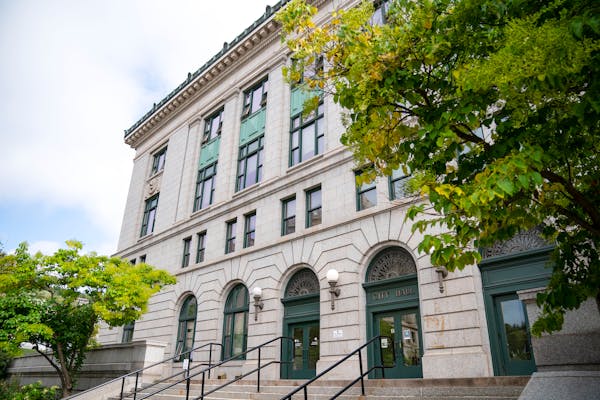DULUTH — The question of how to heat buildings in a cold climate without using fossil fuels keeps sustainability officer Mindy Granley awake at night.
Duluth's answer could be just a flush away.
The city was recently awarded a $700,000 grant from the U.S. Department of Energy to study using wastewater from Western Lake Superior Sanitary District (WLSSD) to heat buildings — a clean energy solution that involves using ready-made heat instead of creating it. In the next year, it will consider the technical and economic feasibility of using this geothermal energy to cover the heating load for 2.4 million square feet of buildings — with the chance to tack on more — in the Lincoln Park neighborhood.
Duluth Mayor Emily Larson said the project is one that could decarbonize hundreds of buildings and stabilize heating fuel prices in the future.
This would be a significant move in the city's goal of carbon neutrality. Heating buildings accounts for nearly half of the world's energy use and about 40% of global carbon dioxide emissions, according to Granley.
"Moving heat around is way more energy efficient than burning fossil fuels to create heat," she said. "Heat recovery is very energy efficient. This project helps us to explore the viability and cost of using heat recovery and geo-exchange in district energy systems to heat buildings."
In introducing the plan earlier this month, Ken Smith of St. Paul-based Ever-Green Energy said it's a concept that has been used in China, Finland and Sweden — but not yet at this scale in the United States.
How it works
It all starts with an easily accessible renewable resource: human waste. The liquid that leaves the body is about 98 degrees before it joins up with other water in the city's thousands of miles of sewer pipes. This mix from toilet flushes, dishwashers, showers and local industry adds up to 38 million gallons a day, according to WLSSD. It's all routed to the wastewater treatment plant between Interstate 35 and the St. Louis River.
It's still warm when it gets there.
First the water is filtered to remove large objects and grit, then sent into a channel where it is injected with pure oxygen and stirred by large paddles. This creates an environment where aerobic bacteria can thrive and digest waste to further clean it. Then the water flows to a clarifying chamber, where sticky clumps of bacteria become sludge that is either used as fertilizer or returned to the channel. It is then sent through sand, gravel and coal to remove smaller solids, and potentially mixed with bleach.
The treated water is then put back into the St. Louis River — or potentially intercepted to use as energy. This is where the new-to-Duluth technology could begin.
Ever-Green Energy's concept is to send the warm and cleaned-up wastewater through a heat exchanger that transfers the heat from the effluent to fresh water in an adjacent pipe. A heat pump lifts the temperature just a bit more to about 140 degrees — capable of warming a building. Air is added to it, through a furnace or other air handling unit, and transferred throughout the building.
CLEANER HEAT JUST A FLUSH AWAY


Duluth has a goal of carbon neutrality and net zero emissions by 2050. A big part of getting there is determining how to heat buildings with something other than natural gas.
"Waste heat from a wastewater treatment plant — which are in or near every community of every scale — is something that should be looked at," Smith said. "It's an idea we've been talking about since we've been involved with Duluth for the past 12 years."
'The potential to be a model for the nation'
AJ Axtell, WLSSD's director of community relations, said they have long known that there was an opportunity to capture heat from effluent at the plant and turn it into energy, but there wasn't a feasible way to fund it. WLSSD, a Lincoln Park fixture since the early 1970s, is already behind a lot of environmental work in this region, between its composting and collection of hazardous waste.
A local coalition led by Granley applied for the grant from the U.S. Department of Energy knowing that 1.6 miles of West Superior Street will undergo major reconstruction in 2026. Creating the underground infrastructure for a geothermal heating district could synch up with an already torn-up thoroughfare. Some of the 11 communities in the country that, like Duluth, were awarded the grant will be selected by the U.S. Department of Energy to receive up to 90% of the implementation costs.
This style of district heating is already in play in Finland, where steep gas prices and fees for carbon emissions have created more urgency for carbon neutrality — potentially why Europe is ahead of the United State in using wastewater to generate heat, according to Timo Piispa, vice president of heating and cooling at Fortum, an energy company in Finland. The company is among the largest of its kind in Northern Europe, and 95% of its energy is carbon neutral.
His company is also behind efforts to capture heat from city data centers in a similar way.
There are about 16,000 water treatment plants in the U.S., Smith said. And they will probably still exist 100 years from now.
"This is a really unique opportunity for reliable, sustainable, carbon-free energy — stable and affordable for this community — by using wasted energy that's already in the community," Smith said. "The innovative geothermal district energy project for Lincoln Park is a bold, big idea that is capable of delivering on those expectations — and it has the potential to be a model for the nation."

University of Minnesota police arrest 9 after pro-Palestinian encampment set up on campus
2 dead in Lino Lakes, no known threat to public, police say
Teen charged with murder in deadly St. Paul shooting last month




